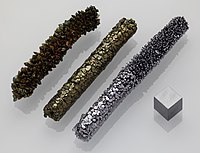
Photo from wikipedia
Abstract The identification of low thermal-conductivity materials that are stable up to high temperatures has been a longstanding challenge for high-temperature thermal management systems such as thermal barrier coatings (TBCs).… Click to show full abstract
Abstract The identification of low thermal-conductivity materials that are stable up to high temperatures has been a longstanding challenge for high-temperature thermal management systems such as thermal barrier coatings (TBCs). Although phonon scattering in crystalline solids can be enhanced by nanometer-scale boundaries as well as well-studied atomic-level point defects, the impact of such extended defects on heat transfer in high-temperature applications remains unclear. Herein, through structural characterization and measurements of the thermophysical properties of rare-earth tantalates with double-perovskite structures (RTa3O9; R = La, Nd, Gd, and Yb), it is shown that YbTa3O9 with spontaneously formed nanostructures has a thermal conductivity lower than two-thirds of that of the commercial-level TBC material, i.e., 7 wt% yttria-stabilized zirconia (7YSZ). These results provide evidence of the close relation between enhanced phonon scattering and boundaries separated by distances of few nanometers which contain periodic strain, octahedral tilting, and twin-boundaries. Furthermore, YbTa3O9 exhibits similar thermal expansion characteristics to 7YSZ without any apparent transition associated with a disrupt change in volume, which suggests its potential as a TBC material. The results demonstrate the capability of tuning closely aligned boundaries in crystals to control thermal transport and tailor low-thermal conductivity materials.
Journal Title: Acta Materialia
Year Published: 2021
Link to full text (if available)
Share on Social Media: Sign Up to like & get
recommendations!